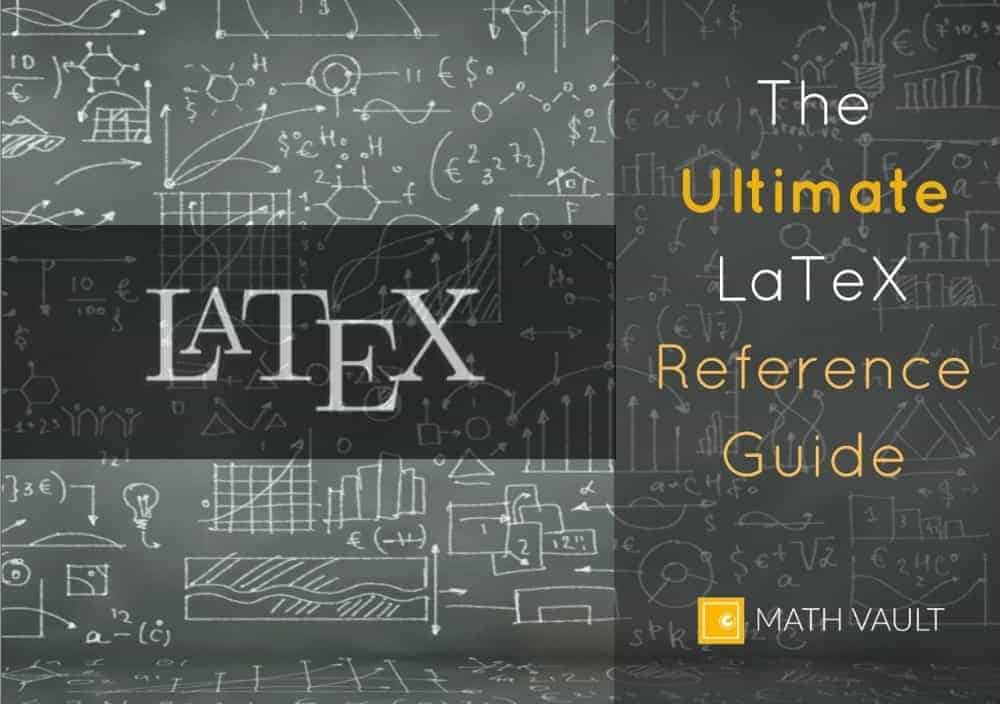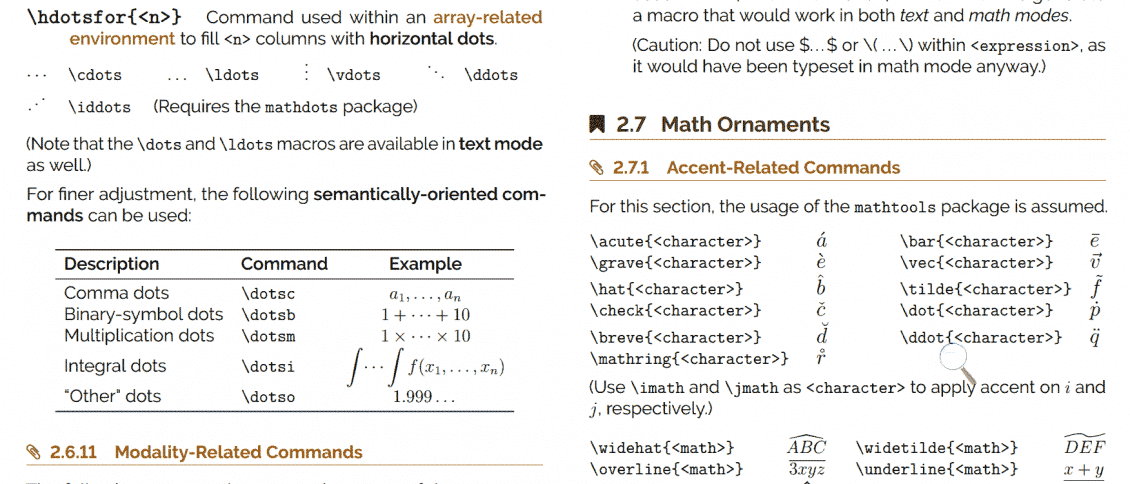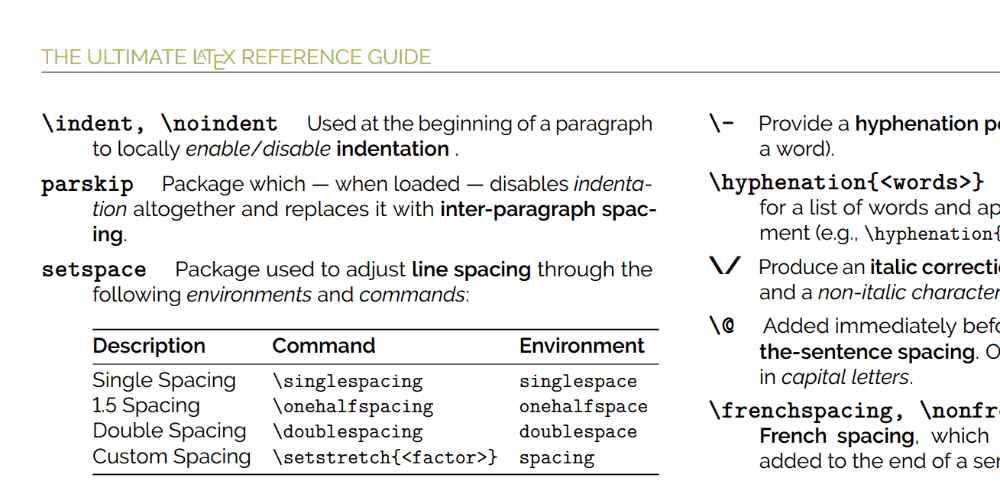Tune up your LaTeX documents in a fraction of time it normally requires.
Most LaTeX guides out there are either too detailed or too superficial. so we decided to create a better one instead.
So here's what happened...
Like some of the math folks out there, we are avid users of LaTeX., but because we have an affinity for tweaking every single detail of a document, we tend to end up looking for things left and right:
- "Jeez. That cute image might look cuter if we reflect it and put a frame around it."
- "Hmm... Let's try drawing a line below the header and see if it exceeds the threshold of un-ugliness."
- "Hey. Who said that we can't put pictograms in a section title? Let's be the black sheep!"
And before you know it, hours of digging and headaches would ensue...

Hmm...How do I do W, X, Y and Z — in that order?
And we're probably not alone either. As with any other sophisticated markup language, LaTeX definitely has its own fair share of intricacy and complexity....
So that's when it hits us...
"What if we were to create an giant LaTeX 'cheat sheet' that would answer all those annoying questions?"
Or even better: "What if we were to create a guide that would include all the LaTeX features deemed essential by the 21st-century publishing standard?
So that's when we went underground and further...
And then, after 6+ weeks of:
We finally managed to condense the said 'essential' LaTeX functionalities into an ultra-condensed 37-page eBook — functionalities which usually take hundreds of pages to cover "in depth".
Introducing the Ultimate LaTeX Reference Guide
A dense-yet-concise catalogue of packages, commands and environments in bullet-point form — with minimally-sufficient explanations to get you going in implementing the codes.
Unlike most LaTeX manuals, the strength of the Ultimate LaTeX Reference Guide is in its brevity and density.
In fact, if you're like us, you might find yourself referring to the guide every now and then during your LaTeXing processes!
Covered Topics
In case you're wondering, here's what the Ultimate LaTeX Reference Guide includes in a nutshell:
Table of Contents
As extracted straight out from the Ultimate LaTeX Reference Guide.
1) Document Structure
1.1) Document Class
1.2) Preamble
1.3) Metadata
1.4) Title Portion
1.5) Front Matter
1.6) Sectioning Commands
1.6.1) Sectional Structures
1.6.2) Sectional Units
2) Typesetting
2.1) Text Symbols
2.2) Text Ornaments
2.3) Preformatted Text
2.4) Modular features
2.4.1) Common Modules
2.4.2) List Environments
2.4.3) Table-Like Environments
2.4.4) Colored Modules
2.5) Float Environments
2.5.1) Introduction
2.5.2) Common Float Environments
2.6) Math Symbols
2.6.1) Greek Alphabets
2.6.2) Hebrew Alphabets
2.6.3) Standalone Symbols
2.6.4) Unary Symbols
2.6.5) Binary Symbols
2.6.6) Logical Symbols
2.6.7) Arrows
2.6.8) Fraction-Related Commands
2.6.9) Large Math Operators
2.6.10) Dots
2.6.11) Modality-Related Commands
2.7) Math Ornaments
2.7.1) Accent-Related Commands
2.7.2) Placement-Related Commands
2.7.3) Arrow/Box-Related Commands
2.8) Delimiters
2.9) Math Environments
2.9.1) Simple Equation Environments
2.9.2) Aligned Equation Environments
2.9.3) Other Equation-Related Environments
2.9.4) Array-Related Environments
2.9.5) Theorem-Like Environments
3) Formatting
3.1) Color
3.1.1) Color Types
3.1.2) Color-Related Commands
3.2) Font
3.2.1) Size
3.2.2) Common Styles
3.2.3) Math-Only Styles
3.2.4) Families
3.3) Length
3.3.1) Units and Types
3.3.2) Length-Related Commands
3.3.3) Common Length Macros
3.4) Counter
3.4.1) Counter-Related Commands
3.4.2) Common Counters
3.5) Spacing
3.5.1) Horizontal
3.5.2) Vertical
3.5.3) Multi-Dimensional
3.6) Filling
3.7) Document-Level Formatting
3.8) Page-Level Formatting
3.9) Column-Level Formatting
3.10) Paragraph-Level Formatting
3.11) Word-Level Formatting
4) Reference
4.1) In-Document Reference
4.2) Bibliography
4.2.1) Manually-Formatted References
4.2.2) BiBLaTeX
4.2.3) Citation Commands
4.3) Index
4.4) Glossary
5) Source-Code-Related Features
6) Additional Resources
Noteworthy Features
Basically, if you're acquainted with the fundamentals of LaTeX, but are somehow:
then the Ultimate LaTeX Reference Guide will help you fill in the knowledge gap, while greatly improving your LaTeXing speed from now onwards.
Put it slightly differently, instead of:
You can leverage from our (not-so-pleasant) experience and acquire extensive knowledge about the vast majority of LaTeX's functionalities in a couple of hours or less...
— and potentially walk away better tools to circumvent your future LaTeX challenges.
You see. We did the heavylifting ourselves so that you don't have to plow your head into countless hours of troubleshooting or research.
And no, we weren't able to find anything similar in the genre — which is why we decided to create it in the first place.
And who knows... If you're anything like us, you may even get used to using it as a handy "reference sheet" every now and then!
Frequently Answered Questions (FAQ)
All right folks. It's the question period.
What will happen after the purchase?
Can a beginner learn LaTeX using the Ultimate LaTeX Reference Guide alone?
Does it cover the installation, the compiling process and the package maintenance aspects of LaTeX?
Wow. Cool stuff! What fancy gadgets did you guys used to develop this guide?
Does it cover every commands, environments and packages available in LaTeX up to now?
What can the Ultimate LaTeX Reference Guide teach me about Beamer and Tikz?
Can you prepare a [insert-the-blank] LaTeX document for me?
What about future editions? Do I have to purchase the guide again from scratch in that case?
Accelerate your LaTeXing process with The Ultimate LaTeX Reference Guide today.


P.S. — Yes. Looks like you just made it through the end of our rambling! For any lingering question, just drop us an email at [email protected] and we'll be happy to help you out!


